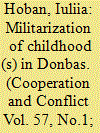| Srl | Item |
| 1 |
ID:
159931


|
|
|
|
|
| Summary/Abstract |
Admiral Stansfield Turner, a former chief of the U.S. Intelligence Community (formally, the Director of Central Intelligence or DCI), died in early 2018. He served as DCI during the Carter Administration, where he was known to be an advocate of stronger intelligence accountability. This previously unpublished interview with him from 1991 discloses his views on a range of intelligence topics, as he reflected back on his experiences a decade after his tenure as DCI.
|
|
|
|
|
|
|
|
|
|
|
|
|
|
|
|
| 2 |
ID:
184043


|
|
|
|
|
| Summary/Abstract |
This essay critically examines how the militarization of childhood(s) takes place in the Luhansk and Donetsk People’s Republics. The intensification of hostilities in Eastern Ukraine in mid-2014 has had a profound impact on local populations, particularly children. While no systematic recruitment and participation of children in conflict has been reported, childhood has become what Agathangelou and Killian would characterize as a ‘site for displacement and maneuvering for militarization.’ Drawing on feminist methodologies, I examine processes of the militarization of children’s everyday lives. This article investigates a range of ways in which authorities of proto-states in the Donbas region address children as participants and potential collaborators in the processes of militarization. In my analysis, I examine how war and preparation for it are simultaneously co-constituted by the geopolitical—legitimation of new proto-states—and everyday practices, such as engaging with school curricula, visiting museums, and (re)inventing historical narratives. Understanding of mechanisms that militarize childhood and how children become subjects and objects of militarization allows for a critical analysis that reveals spaces of everyday violence. This article, therefore, enhances our understanding about the intersections of childhood, militarism, and security.
|
|
|
|
|
|
|
|
|
|
|
|
|
|
|
|